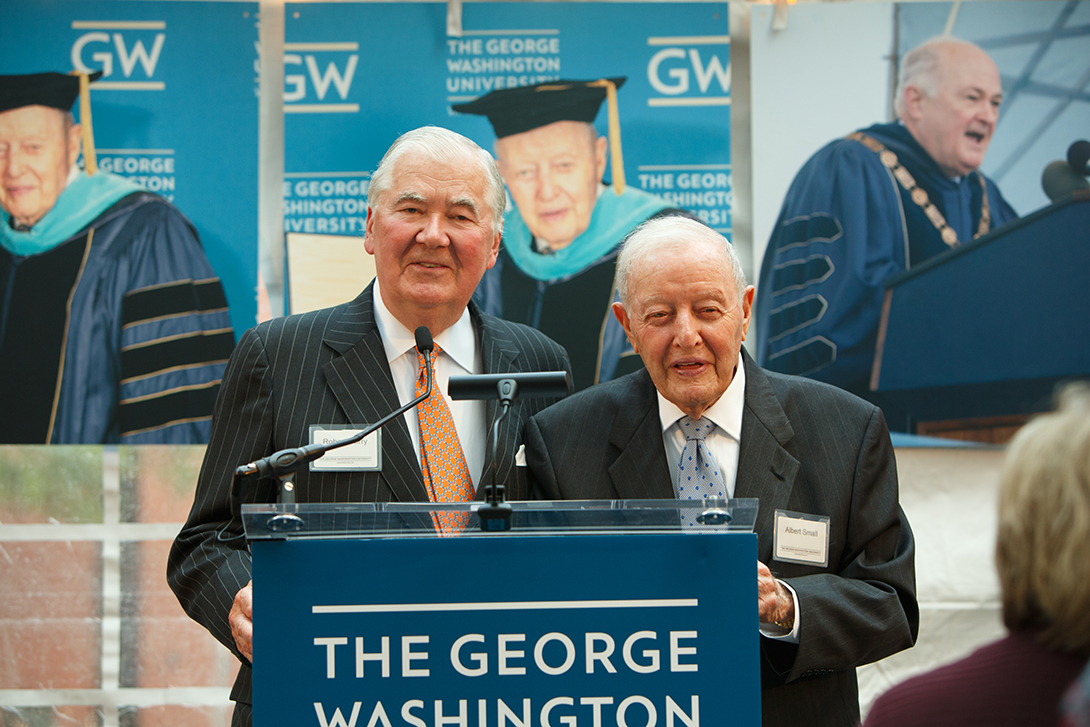By Willona M. Sloan
Although they used the same atlas from the Albert H. Small Washingtoniana Collection, the two George Washington University student presenters at Wednesday’s Albert H. Small Symposium followed separate paths when researching the development of the Foggy Bottom neighborhood.
Muhammad Mohsin focused on Columbia Plaza at 23rd and E streets, NW. Using maps that detailed every block in the city, Mr. Mohsin learned that buildings that existed before the development of the shopping plaza and apartment complex now at that intersection housed low-income residents in a once industrial neighborhood.
“Foggy Bottom went through multiple cycles of change. It went from a proposed neighborhood to an industrial sector because of the location. As Washington, D.C., grew, a lot of the city’s underprivileged started to live in Foggy Bottom,” said Mr. Mohsin. With the development of Columbia Plaza for wealthier residents, the neighborhood was completely changed, he said.
Mr. Mohsin is a student in GW’s Early College Program, which is a partnership between GW and D.C. Public Schools. He is enrolled at both the School Without Walls High School and GW, where he will earn an associate of arts degree.
Cassidy Elkins, a sophomore in the Columbian College of Arts and Sciences, focused on proving her hypothesis that Foggy Bottom was developed in a linear manner that seamlessly integrated the Metro stop and the George Washington University Hospital.
“I am a very hands-on learner,” Ms. Elkins said. “I leapt into the collection and pieced my argument together.”
As she analyzed surveys from 1909 and 1965, she realized that her theory was not correct. In fact, from analyzing the types of buildings detailed on the maps, it seemed that Foggy Bottom’s development regressed over a period of time before the area was again revitalized and redeveloped. Though surprised by her discovery, she was also excited about what she learned.
The annual symposium, which is in its sixth year, showcases how GW students use the treasures of the Washingtoniana Collection, which includes nearly 1,000 manuscripts, maps, newspapers and more.
The opportunity to use primary source documents to test theories, research ideas and make discoveries is exactly why Christopher Klemek, associate professor of history, incorporates the Washingtoniana Collection, which is housed at the George Washington University Museum and The Textile Museum, into his urban studies courses.
“The museum is an important public platform to showcase and to honor advanced D.C. history research of the highest caliber. Just as importantly, I think it offers a laboratory and a training ground for beginning urban history researchers,” Dr. Klemek said.
The collection, which was donated to the university by Albert H. Small in 2011, will offer rewards for the GW community for years to come.
“All of the faculty are looking forward to opportunities to work with our students in this rich collection,” said Teresa Murphy, deputy provost for academic affairs.
In addition to the research resources, the Albert H. Small Center for National Capital Area Studies offers programs like the D.C. history lecture series at noon on Mondays and internship opportunities.
Mr. Small, who will turn 91 this month, is a third-generation Washingtonian and president of Southern Engineering Corporation. His interest in historical collecting developed after he served in the Navy during World War II.
“There is a Latin term, ‘veritas.’ Romans used it to identify strength, courage, patriotism and generosity. This word was used to describe George Washington. It also describes Albert Small,” said Robert G. Perry, B.S. ’70, special advisor to the George Washington University Museum and chair of the National Trust for the Humanities.
In May, GW awarded Mr. Small an honorary Doctor of Public Service degree. With special guests including Mr. Small’s family, U.S. Rep. Don Beyer (D-Va.), D.C. Council member Jack Evans (D-Ward 2) and former Virginia Gov. Jim Gilmore (R), the symposium provided the perfect occasion to celebrate.
“[Mr. Small] is a great friend to the city, this nation and this university,” said George Washington President Steven Knapp, who honored Mr. Small during the reception.
Mr. Perry also read a letter from former Supreme Court Justice Sandra Day O’Connor, congratulating Mr. Small on his honorary degree.
In his remarks, Mr. Small simply said, “Thank you” to the GW community and his guests for sharing the honor and celebration with him.


